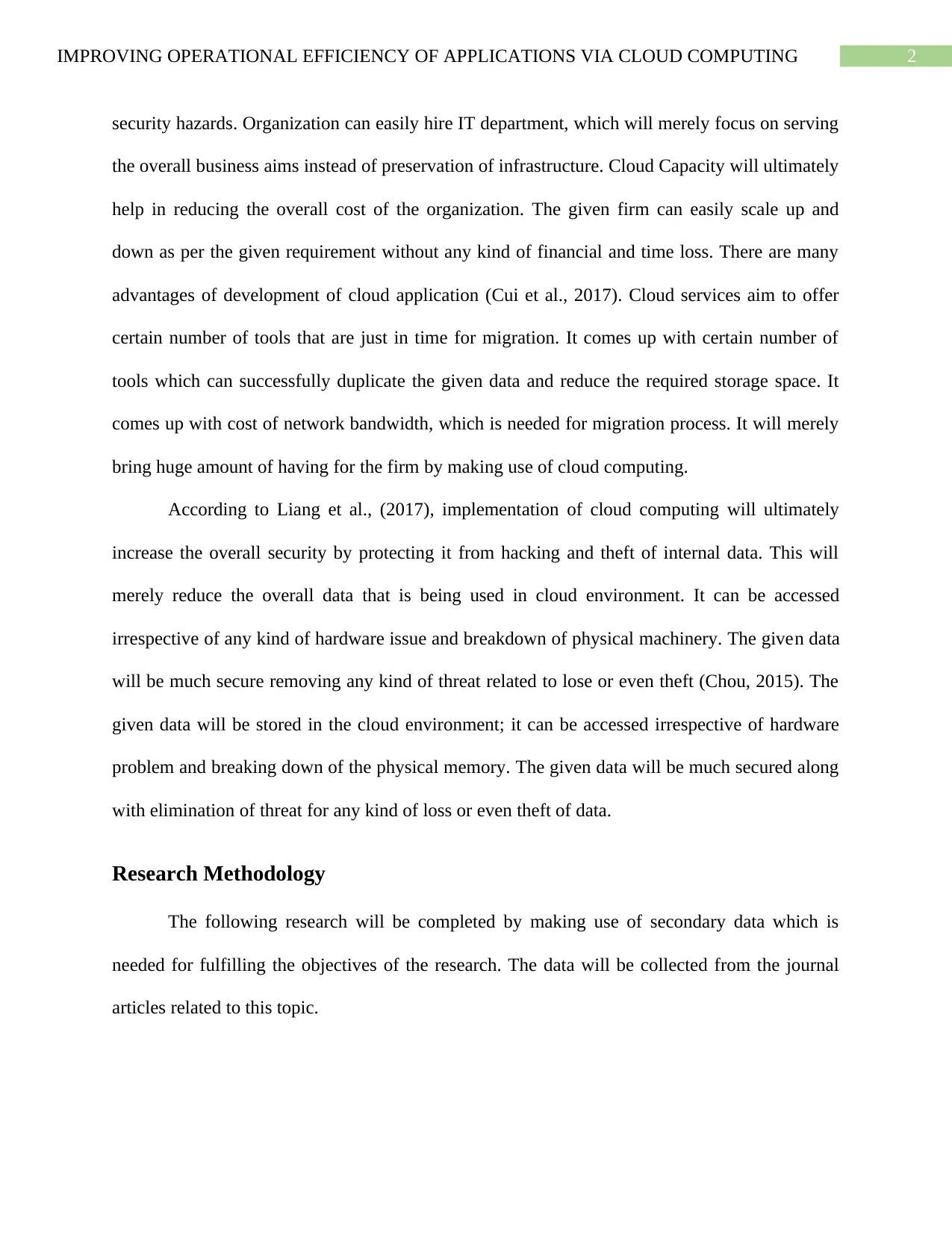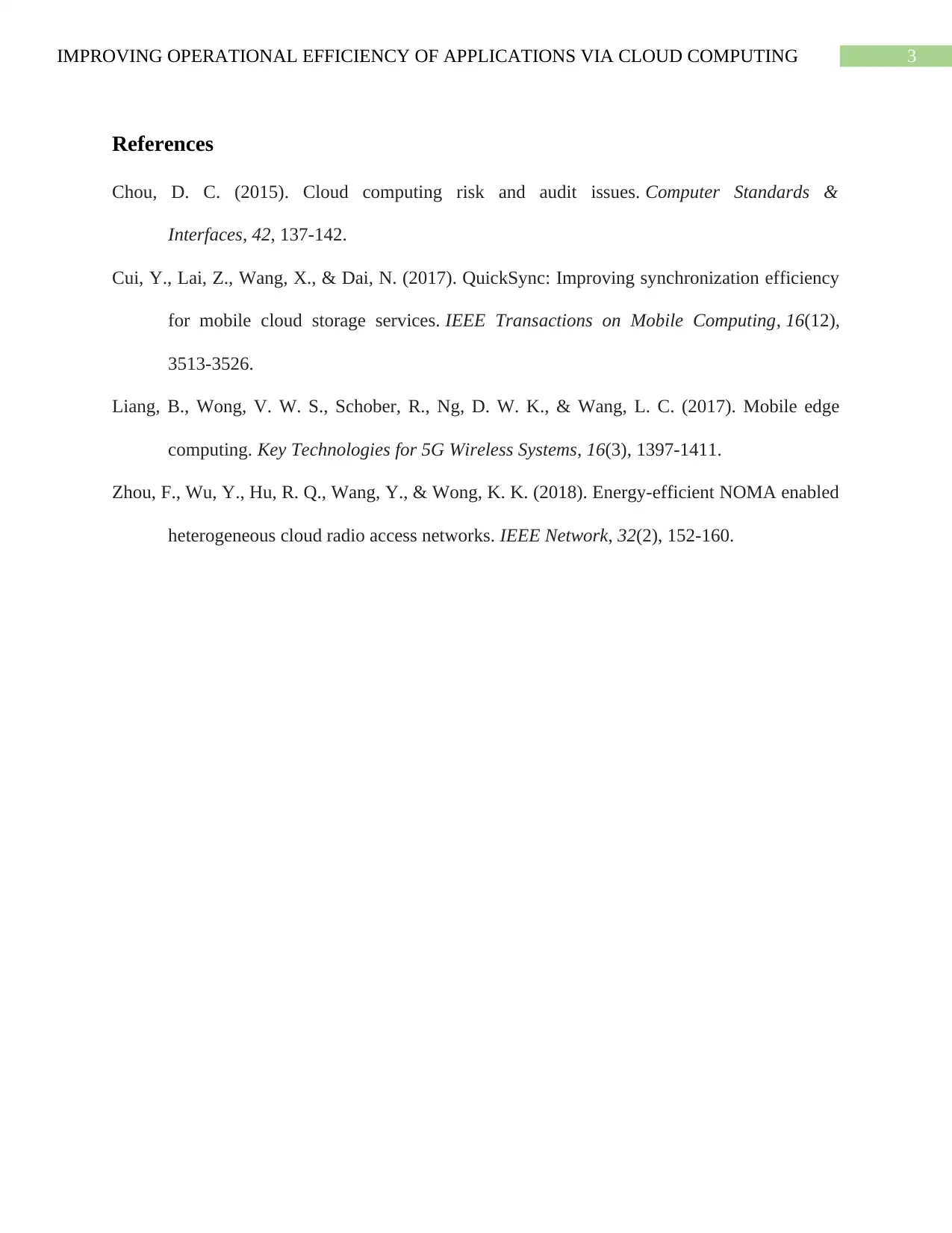Improving Applications' Operational Efficiency via Cloud Computing
VerifiedAdded on 2022/11/30
|4
|759
|417
Report
AI Summary
This report investigates the impact of cloud computing on improving the operational efficiency of applications. It explores the benefits of cloud migration, including reduced IT dependence, cost reduction, scalability, augmented security, and enhanced remote collaboration. The report provides a literature review, citing various research papers to support its claims, and outlines the research methodology. The analysis highlights how cloud computing offers tools for data duplication and storage, increases security, and reduces the overall cost of operation, making applications more efficient. The study utilizes secondary data from journal articles to achieve its objectives, providing a comprehensive overview of the topic and its implications for businesses.

Running head: IMPROVING OPERATIONAL EFFICIENCY OF APPLICATIONS VIA
CLOUD COMPUTING
Improving Operational Efficiency of Applications via Cloud Computing
Name of the Student
Name of the University
Author Note:
CLOUD COMPUTING
Improving Operational Efficiency of Applications via Cloud Computing
Name of the Student
Name of the University
Author Note:
Paraphrase This Document
Need a fresh take? Get an instant paraphrase of this document with our AI Paraphraser

1IMPROVING OPERATIONAL EFFICIENCY OF APPLICATIONS VIA CLOUD COMPUTING
Topic: Improving Operational Efficiency of Applications via Cloud
Computing
Introduction
Cloud migration can be stated as the distribution for various activities which is taken
organization in the process of migration. It merely comprises of business elements for cloud
computing environment in speedy way (Chou, 2015). Some of the most important aspects are
low cost, rapid scalability and overall flexibility. Cloud computing will merely help the firm in
having alertness and speed that affects the overall operational efficiency.
Research objective
To understand the benefits of operational efficiency by the help of cloud computing
Extreme Drop in IT dependence and impediment
Cutting Cost and Scalability
Augmented Security
Facility of remote collaboration.
Literature Review
As stated by Zhou et al., (2018), organization will merely pay for the cloud computing
application, which is used by them. They do not provide any kind of big project for producing
support and management of IT teams. It will merely help in reducing the overall cost of
operation, which will help in improve their IT processes. Providers of cloud service will have
huge number of challenges like electronic hardware keeping the whole thing in workable
environment. This will merely aim in protecting from both cyber-security and any kind of
Topic: Improving Operational Efficiency of Applications via Cloud
Computing
Introduction
Cloud migration can be stated as the distribution for various activities which is taken
organization in the process of migration. It merely comprises of business elements for cloud
computing environment in speedy way (Chou, 2015). Some of the most important aspects are
low cost, rapid scalability and overall flexibility. Cloud computing will merely help the firm in
having alertness and speed that affects the overall operational efficiency.
Research objective
To understand the benefits of operational efficiency by the help of cloud computing
Extreme Drop in IT dependence and impediment
Cutting Cost and Scalability
Augmented Security
Facility of remote collaboration.
Literature Review
As stated by Zhou et al., (2018), organization will merely pay for the cloud computing
application, which is used by them. They do not provide any kind of big project for producing
support and management of IT teams. It will merely help in reducing the overall cost of
operation, which will help in improve their IT processes. Providers of cloud service will have
huge number of challenges like electronic hardware keeping the whole thing in workable
environment. This will merely aim in protecting from both cyber-security and any kind of

2IMPROVING OPERATIONAL EFFICIENCY OF APPLICATIONS VIA CLOUD COMPUTING
security hazards. Organization can easily hire IT department, which will merely focus on serving
the overall business aims instead of preservation of infrastructure. Cloud Capacity will ultimately
help in reducing the overall cost of the organization. The given firm can easily scale up and
down as per the given requirement without any kind of financial and time loss. There are many
advantages of development of cloud application (Cui et al., 2017). Cloud services aim to offer
certain number of tools that are just in time for migration. It comes up with certain number of
tools which can successfully duplicate the given data and reduce the required storage space. It
comes up with cost of network bandwidth, which is needed for migration process. It will merely
bring huge amount of having for the firm by making use of cloud computing.
According to Liang et al., (2017), implementation of cloud computing will ultimately
increase the overall security by protecting it from hacking and theft of internal data. This will
merely reduce the overall data that is being used in cloud environment. It can be accessed
irrespective of any kind of hardware issue and breakdown of physical machinery. The given data
will be much secure removing any kind of threat related to lose or even theft (Chou, 2015). The
given data will be stored in the cloud environment; it can be accessed irrespective of hardware
problem and breaking down of the physical memory. The given data will be much secured along
with elimination of threat for any kind of loss or even theft of data.
Research Methodology
The following research will be completed by making use of secondary data which is
needed for fulfilling the objectives of the research. The data will be collected from the journal
articles related to this topic.
security hazards. Organization can easily hire IT department, which will merely focus on serving
the overall business aims instead of preservation of infrastructure. Cloud Capacity will ultimately
help in reducing the overall cost of the organization. The given firm can easily scale up and
down as per the given requirement without any kind of financial and time loss. There are many
advantages of development of cloud application (Cui et al., 2017). Cloud services aim to offer
certain number of tools that are just in time for migration. It comes up with certain number of
tools which can successfully duplicate the given data and reduce the required storage space. It
comes up with cost of network bandwidth, which is needed for migration process. It will merely
bring huge amount of having for the firm by making use of cloud computing.
According to Liang et al., (2017), implementation of cloud computing will ultimately
increase the overall security by protecting it from hacking and theft of internal data. This will
merely reduce the overall data that is being used in cloud environment. It can be accessed
irrespective of any kind of hardware issue and breakdown of physical machinery. The given data
will be much secure removing any kind of threat related to lose or even theft (Chou, 2015). The
given data will be stored in the cloud environment; it can be accessed irrespective of hardware
problem and breaking down of the physical memory. The given data will be much secured along
with elimination of threat for any kind of loss or even theft of data.
Research Methodology
The following research will be completed by making use of secondary data which is
needed for fulfilling the objectives of the research. The data will be collected from the journal
articles related to this topic.
⊘ This is a preview!⊘
Do you want full access?
Subscribe today to unlock all pages.

Trusted by 1+ million students worldwide

3IMPROVING OPERATIONAL EFFICIENCY OF APPLICATIONS VIA CLOUD COMPUTING
References
Chou, D. C. (2015). Cloud computing risk and audit issues. Computer Standards &
Interfaces, 42, 137-142.
Cui, Y., Lai, Z., Wang, X., & Dai, N. (2017). QuickSync: Improving synchronization efficiency
for mobile cloud storage services. IEEE Transactions on Mobile Computing, 16(12),
3513-3526.
Liang, B., Wong, V. W. S., Schober, R., Ng, D. W. K., & Wang, L. C. (2017). Mobile edge
computing. Key Technologies for 5G Wireless Systems, 16(3), 1397-1411.
Zhou, F., Wu, Y., Hu, R. Q., Wang, Y., & Wong, K. K. (2018). Energy-efficient NOMA enabled
heterogeneous cloud radio access networks. IEEE Network, 32(2), 152-160.
References
Chou, D. C. (2015). Cloud computing risk and audit issues. Computer Standards &
Interfaces, 42, 137-142.
Cui, Y., Lai, Z., Wang, X., & Dai, N. (2017). QuickSync: Improving synchronization efficiency
for mobile cloud storage services. IEEE Transactions on Mobile Computing, 16(12),
3513-3526.
Liang, B., Wong, V. W. S., Schober, R., Ng, D. W. K., & Wang, L. C. (2017). Mobile edge
computing. Key Technologies for 5G Wireless Systems, 16(3), 1397-1411.
Zhou, F., Wu, Y., Hu, R. Q., Wang, Y., & Wong, K. K. (2018). Energy-efficient NOMA enabled
heterogeneous cloud radio access networks. IEEE Network, 32(2), 152-160.
1 out of 4
Related Documents
Your All-in-One AI-Powered Toolkit for Academic Success.
+13062052269
info@desklib.com
Available 24*7 on WhatsApp / Email
![[object Object]](/_next/static/media/star-bottom.7253800d.svg)
Unlock your academic potential
Copyright © 2020–2025 A2Z Services. All Rights Reserved. Developed and managed by ZUCOL.



